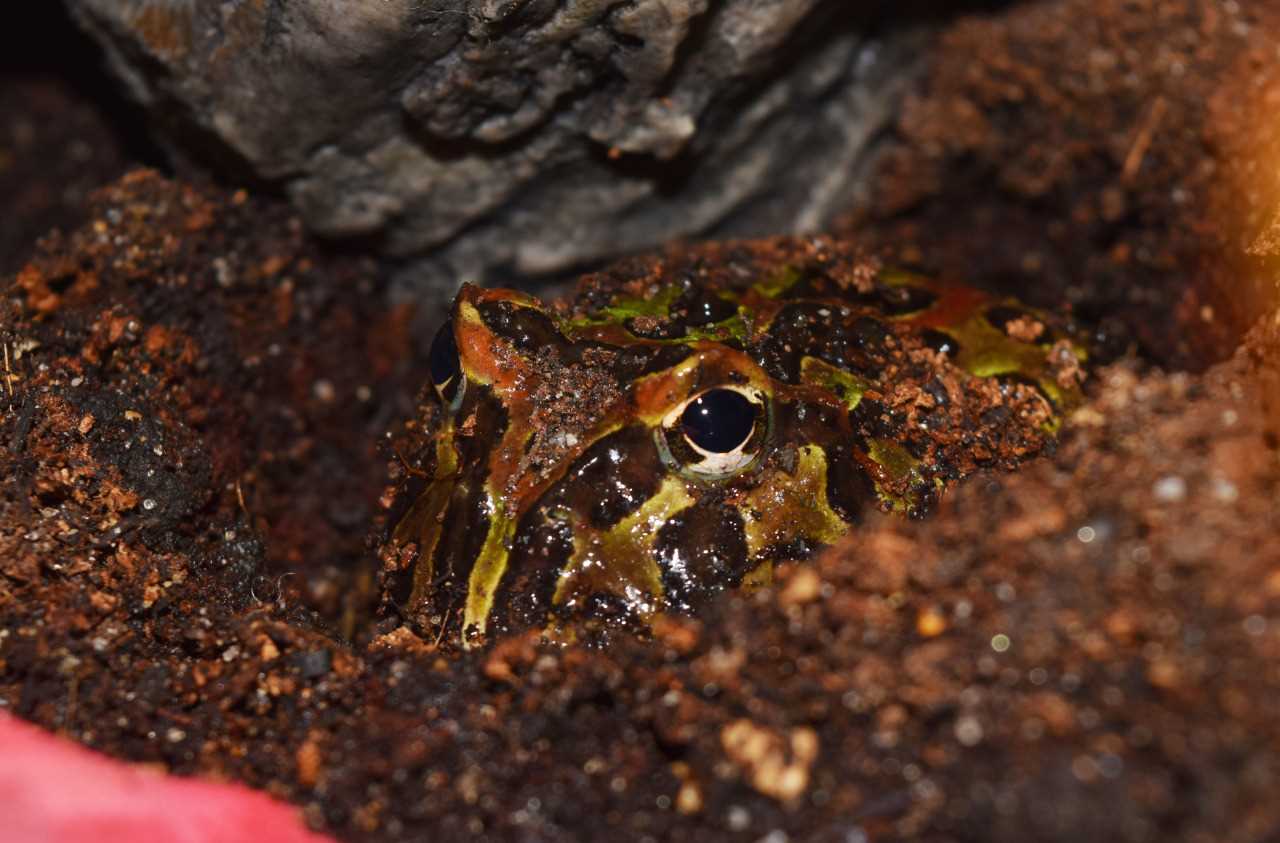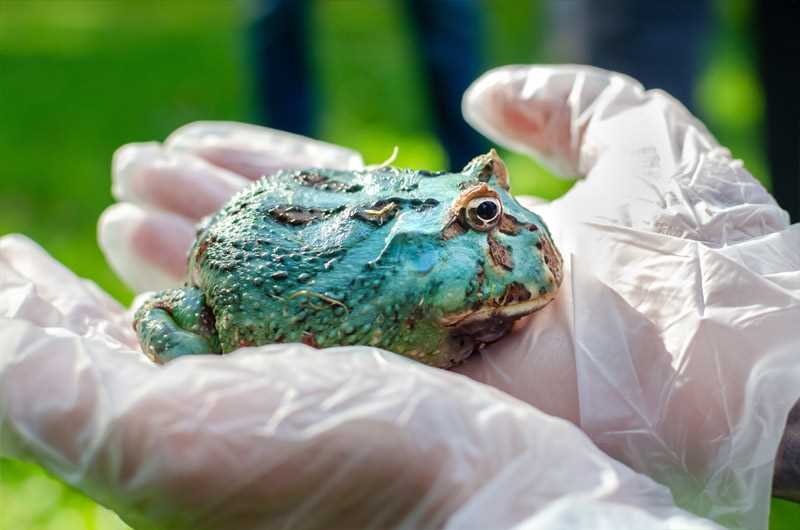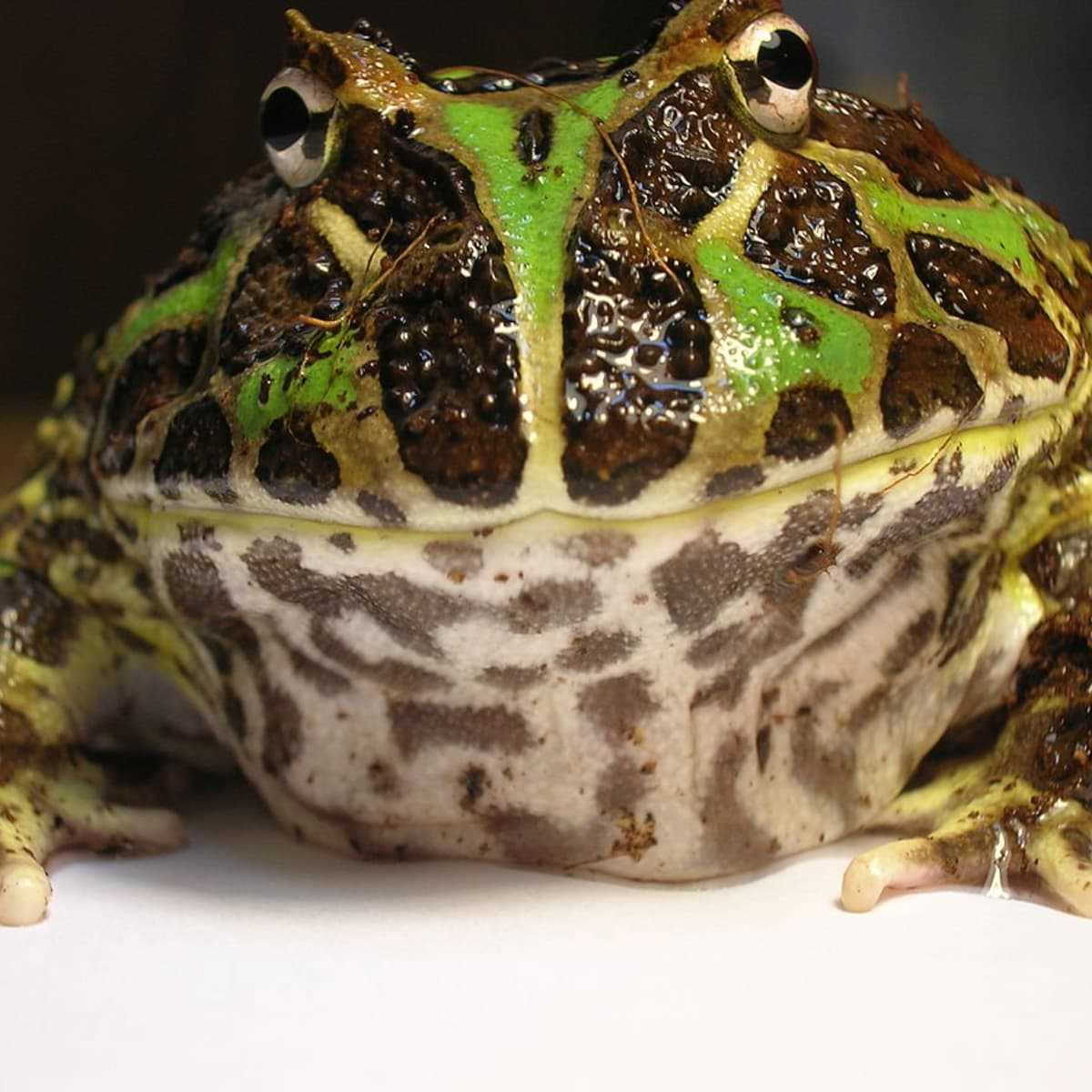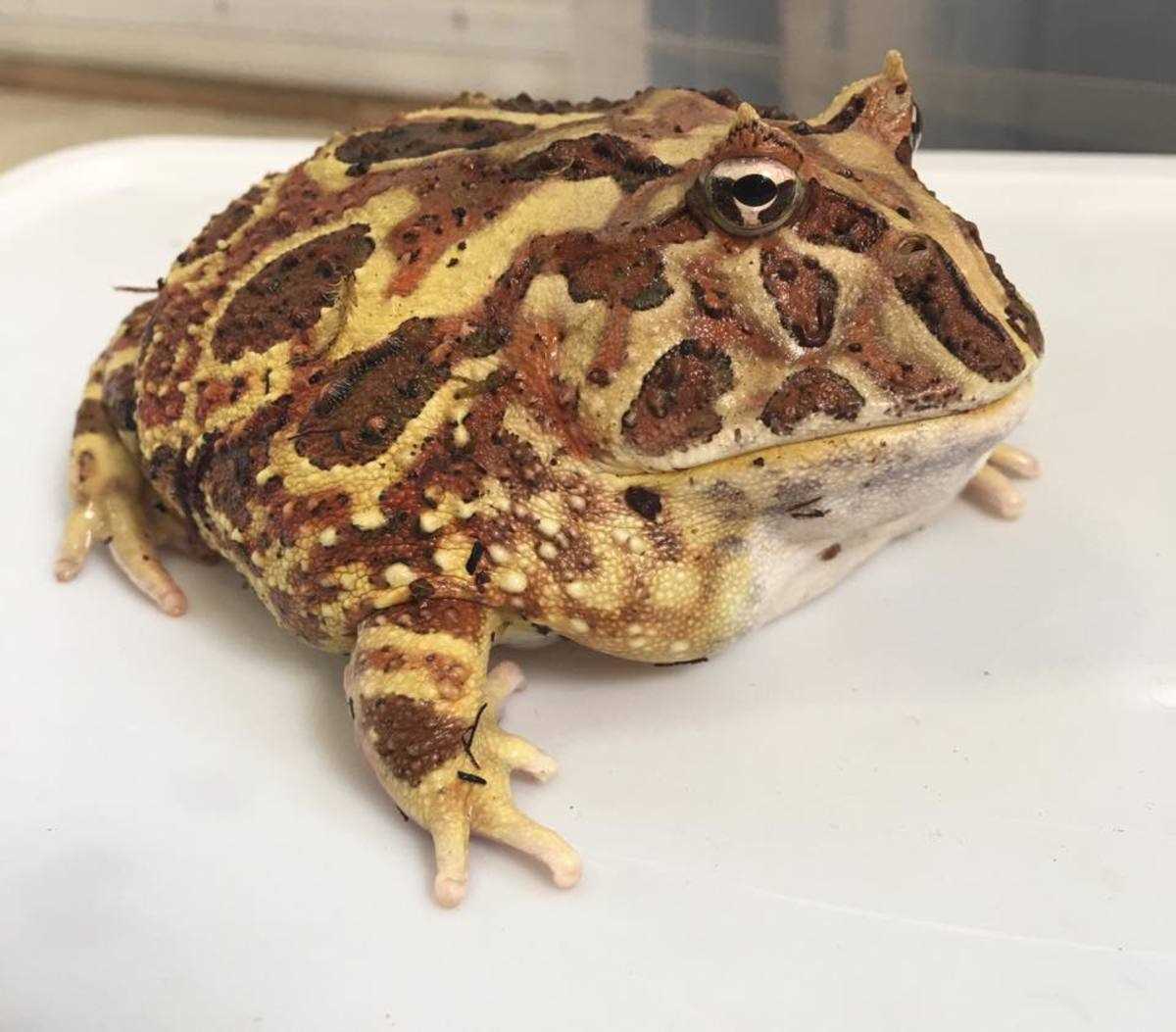Humidity is a crucial factor to consider when caring for a Pacman frog. These amphibians are native to the tropical rainforests of South America, where humidity levels can reach up to 100%. Maintaining the right humidity level in their enclosure is essential for the health and well-being of your pet frog.
Pacman frogs have semi-permeable skin, which means they can absorb water directly through their skin. They rely on high humidity levels to keep their skin moist and to facilitate respiration. If the humidity in their enclosure drops too low, they can become dehydrated, which can lead to serious health issues.
It’s recommended to keep the humidity level in a Pacman frog’s enclosure between 70% and 80%. This can be achieved by misting the enclosure daily with dechlorinated water and providing a water dish for the frog to soak in. It’s also important to use a substrate that retains moisture well, such as coconut husk or sphagnum moss.
Monitoring the humidity levels in your Pacman frog’s enclosure is crucial. Investing in a good quality hygrometer will help you keep track of the humidity levels and make adjustments as needed. By providing the right humidity for your Pacman frog, you are ensuring a healthy and happy pet that will thrive in its environment.
Humidity is a crucial factor to consider when keeping a Pacman frog as a pet. These amphibians are native to tropical regions, where high humidity levels are common. Providing the appropriate humidity in their terrarium is essential for the health and well-being of these frogs.
The Perfect Humidity Range
Pacman frogs require a humidity level of 50-80%. This range mimics the humid conditions of their natural habitat and allows them to thrive in captivity. Maintaining the correct humidity level is vital for their skin health, respiration, and overall immune function.
Importance of Humidity for Skin Health
The Pacman frog’s skin is highly permeable, meaning it can easily absorb moisture and substances from its environment. Adequate humidity helps keep their skin moist and supple, preventing dehydration and the risk of skin infections. Dry conditions can lead to shedding problems and make the frog more susceptible to other health issues.
Respiration and Moisture Balance
Pacman frogs primarily breathe through their skin, so proper humidity is crucial for their respiratory function. High humidity helps keep their skin moist, allowing them to take in oxygen more efficiently. It also aids in maintaining the moisture balance within their bodies, preventing dehydration.
Creating the Ideal Humid Environment
To provide the right humidity for your Pacman frog, there are several methods you can use. One popular method is misting the terrarium regularly using a spray bottle to increase humidity levels. Another option is using a humidifier or fogger, especially for larger enclosures. These devices can help maintain a consistent level of humidity throughout the terrarium.
It is also important to create a suitable substrate for your Pacman frog. A combination of coconut coir, sphagnum moss, and topsoil can help retain moisture and provide a humid microclimate within the enclosure.
Monitoring and Adjusting Humidity Levels
To ensure the humidity levels are appropriate, it is essential to monitor them regularly using a hygrometer. This device measures the humidity percentage in the terrarium, allowing you to make any necessary adjustments. If the humidity falls below the recommended range, you can mist more frequently or add a moist hideout for your frog to seek refuge.
Preventing Excessive Humidity
While high humidity is essential, excessive humidity can also be detrimental to your Pacman frog. It can lead to various health issues like respiratory infections and skin problems. Always strive to maintain the recommended humidity range and avoid excessive moisture buildup within the terrarium.
Importance of Proper Pacman Frog Humidity
Why is humidity important for pacman frogs?
Pacman frogs have semi-permeable skin, which means they can absorb moisture from their surroundings. Adequate humidity in the terrarium helps keep their skin moist and prevents dehydration. Without proper humidity, the frog’s skin can become dry, leading to shedding issues, difficulty breathing, and overall poor health.
In addition to maintaining the frog’s hydration, humidity also plays a vital role in the pacman frog’s respiratory system. These frogs have a unique breathing mechanism that allows them to breathe through their skin, making them highly sensitive to even slight changes in humidity levels. Insufficient humidity can result in respiratory problems, such as difficulty breathing and respiratory infections.
Impact of improper humidity on pacman frogs
If the humidity levels in the pacman frog’s environment are too low, it can have detrimental effects on their health. Dry and brittle skin can lead to complications during shedding, causing the frog to have difficulty removing the old dead skin. This can lead to skin infections and other skin-related issues.
Low humidity can also result in dehydration, which has serious implications for pacman frogs. Dehydration can lead to organ failure, loss of appetite, lethargy, and even death if not addressed in a timely manner.
Providing the right humidity for pacman frogs
Creating and maintaining the proper humidity levels for pacman frogs requires careful attention to their terrarium environment. The ideal humidity range for pacman frogs is generally around 70% to 80%. This can be achieved by misting the enclosure regularly and using a hygrometer to monitor humidity levels.
Common Mistakes in Pacman Frog Humidity Management

1. Not providing a proper humidity range: Pacman frogs require a humidity level of around 50-80%. Many owners make the mistake of not providing enough humidity or keeping it too high for extended periods. It’s crucial to maintain the appropriate range to prevent dehydration or respiratory problems.
2. Neglecting to monitor humidity levels: Some owners may not pay enough attention to the humidity levels in their frog’s terrarium. It’s essential to regularly monitor the levels using a hygrometer and make adjustments as needed. Ignoring this aspect can lead to health issues for your Pacman frog.
4. Lack of proper ventilation: While high humidity is necessary for Pacman frogs, it’s equally important to ensure proper air circulation. Inadequate ventilation can lead to stagnant air, which increases the risk of bacterial or fungal growth. Make sure to provide good airflow by including ventilation holes in the terrarium or using a mesh lid.
5. Over misting the terrarium: Some owners may overuse misters or spray bottles to increase humidity levels. However, excessive misting can lead to a continuously wet environment, which can promote the growth of harmful bacteria or molds. It’s best to mist the terrarium lightly and allow it to dry out between misting sessions.
6. Failing to provide hiding spots: Pacman frogs require hiding spots within their terrarium to regulate their exposure to humidity. These hiding spots should be kept slightly more humid than the rest of the enclosure to allow the frog to retreat and maintain its preferred level of moisture.
By avoiding these common mistakes, you can ensure that your Pacman frog’s humidity levels are properly managed, promoting its overall health and well-being.
How to Measure Pacman Frog Humidity
Measuring and maintaining the humidity levels in a Pacman frog’s terrarium is crucial to ensuring its overall health and well-being. Here are some methods you can use to accurately measure the humidity levels:
1. Hygrometer
A hygrometer is a device specifically designed to measure humidity levels. It is an essential tool for any Pacman frog owner as it provides accurate readings. Hygrometers are available in both analog and digital forms. Digital hygrometers tend to be more precise and easier to read. Place the hygrometer inside the terrarium to monitor the humidity levels.
2. Condensation
Another way to gauge the humidity levels is by observing the condensation on the walls or glass of the terrarium. If you notice a significant amount of condensation, it indicates that the humidity is too high. On the other hand, if there is no condensation at all, it means the humidity is too low.
3. Behavioral Cues
4. Mist Test
Using a combination of these methods will provide a more accurate picture of the humidity levels in your Pacman frog’s terrarium. Regular monitoring and adjustments will help ensure that the humidity remains within the appropriate range for your frog’s health and well-being.
Creating an Ideal Pacman Frog Terrarium Environment
Creating and maintaining the ideal environment for your Pacman frog is crucial for its health and well-being. One important factor to consider is humidity. Pacman frogs are native to the humid rainforests of South America, so replicating this environment in their terrarium is essential.
Why is humidity important for Pacman frogs?
Humidity plays a vital role in the overall health and survival of Pacman frogs. These amphibians have thin, delicate skin that is highly susceptible to dehydration. In the wild, they rely on high humidity levels to keep their skin moist and prevent drying out. Without proper humidity, Pacman frogs can become dehydrated, leading to serious health issues.
How to maintain the right humidity levels

To create an ideal terrarium environment for your Pacman frog, you need to maintain proper humidity levels. Here are some steps you can take:
1. Use a hygrometer:
A hygrometer is a device that measures humidity levels. It is essential to have one in your Pacman frog’s terrarium to monitor and adjust humidity as needed.
2. Mist the enclosure:
Misting the terrarium with water is an effective way to increase humidity. This can be done using a spray bottle or a misting system. Aim to mist the enclosure at least once or twice a day, paying close attention to the substrate and the walls of the terrarium.
3. Provide a humidity hide:
A humidity hide is a sheltered area within the terrarium that retains moisture. This can be a small hideout made from a box or a plastic container filled with damp moss or sphagnum moss. Place it in a corner of the terrarium where your Pacman frog can retreat and find high humidity if needed.
4. Choose appropriate substrate:
The substrate you use in the terrarium can also help maintain humidity. Opt for a substrate that retains moisture well, such as coconut husk or sphagnum moss. Avoid using substrates that dry out quickly, like sand or gravel.
5. Use a humidity dome:
If you live in a particularly dry climate, you may need to invest in a humidity dome. A humidity dome is a cover that fits over part of the terrarium, helping to trap moisture inside and maintain higher humidity levels.
Monitoring and adjusting humidity levels

The consequences of improper humidity
If the humidity levels in the terrarium are not properly maintained, Pacman frogs can suffer from dehydration. Dehydration can lead to health issues such as dry skin, difficulty in shedding, respiratory problems, and even death. Therefore, it is crucial to provide and maintain the right humidity levels for the well-being of your Pacman frog.
Tips for Maintaining Pacman Frog Humidity Levels
Maintaining proper humidity levels is crucial for the health and well-being of your Pacman frog. Here are some tips to help you maintain the optimal humidity levels in your frog’s terrarium:
1. Use a hygrometer: A hygrometer is a device that measures humidity levels. It is essential to have one in your Pacman frog’s terrarium to accurately monitor the humidity levels. Place the hygrometer in a spot where you can easily read it.
2. Provide a water source: Ensure that your Pacman frog has access to fresh, clean water at all times. You can use a shallow dish or a small water bowl to provide water for your frog. This will help maintain the humidity levels in the terrarium.
3. Mist the terrarium: Pacman frogs require high humidity, and misting the terrarium regularly is an effective way to increase humidity. Use a spray bottle filled with dechlorinated water to mist the enclosure daily. Focus on misting the substrate, foliage, and the sides of the enclosure.
5. Provide hiding spots: Pacman frogs are burrowers and love to hide. Adding hiding spots such as branches, rocks, or plants will not only make your frog feel secure but also help maintain humidity levels. These hiding spots will trap moisture, creating a more humid microclimate within the terrarium.
6. Cover the terrarium: Use a lid or cover on the terrarium to trap in moisture and maintain a consistent humidity level. Make sure there are small ventilation holes for air exchange to prevent the build-up of stagnant air.
7. Monitor and adjust: Regularly monitor the humidity levels in the terrarium using the hygrometer. If the humidity levels are too low, increase misting frequency or add a humidifier to the enclosure. If the levels are too high, decrease misting or increase ventilation.
8. Avoid drastic changes: Pacman frogs are sensitive to sudden changes in humidity. Avoid making drastic changes to the humidity levels as this can stress your frog and lead to health issues. Instead, make gradual adjustments to maintain a stable and comfortable environment for your Pacman frog.
Remember, maintaining proper humidity levels is essential for the overall health and well-being of your Pacman frog. By following these tips, you can create and maintain a humid terrarium environment conducive to your frog’s needs.
Preventing Pacman Frog Dehydration
Proper humidity levels are crucial for maintaining the health and well-being of your Pacman frog. These unique amphibians have specialized skin that allows them to absorb moisture from their environment, making them highly susceptible to dehydration.
Dehydration can result in a variety of health issues for Pacman frogs, including dry skin, difficulty shedding their skin, impaired digestion, and even organ failure. Therefore, it is essential for Pacman frog owners to take proactive measures to prevent dehydration.
1. Provide a Moist Substrate
One of the most effective ways to maintain humidity in your Pacman frog’s terrarium is by using a moist substrate. This can be achieved by mixing water into the substrate material, such as coconut fiber or sphagnum moss, to create a damp but not soaking wet environment.
Make sure to regularly monitor the substrate’s moisture level and adjust as needed. If the substrate starts to dry out, misting it with water or adding more water can help replenish the moisture content.
2. Use a Water Dish
In addition to a moist substrate, providing a shallow water dish in your frog’s enclosure is also beneficial. Pacman frogs will often soak in the water dish to absorb moisture through their skin. The water dish should be large enough for the frog to comfortably sit in but not deep enough for it to submerge.
Make sure to clean and replenish the water in the dish regularly to prevent bacterial growth and ensure a constant source of freshwater for your Pacman frog.
3. Regularly Mist the Enclosure

Misting the terrarium with water is another effective method for maintaining humidity levels. Use a spray bottle to lightly mist the walls, substrate, and decorations in the enclosure. This will help increase the moisture in the air, creating a humid environment for your Pacman frog.
However, be cautious not to oversaturate the enclosure, as excessive moisture can lead to bacterial and fungal growth. Aim to mist the enclosure once or twice a day, monitoring the humidity levels and adjusting the frequency as needed.
4. Monitor Humidity Levels
Investing in a digital hygrometer is essential for accurately monitoring the humidity levels in your Pacman frog’s terrarium. This device will provide real-time readings, allowing you to adjust humidity levels accordingly.
Regularly check the hygrometer to ensure the humidity levels are within the appropriate range, and make adjustments as needed by misting the enclosure, adding or removing substrate, or adjusting the ventilation.
Conclusion
Preventing Pacman frog dehydration should be a top priority for every owner. By providing a moist substrate, a water dish, regular misting, and monitoring humidity levels, you can help ensure that your Pacman frog remains hydrated and healthy. Maintaining proper humidity is crucial for their overall well-being, proper shedding, and digestion. Remember to regularly monitor and adjust humidity levels to create the optimal environment for your pet.
Humidity-Related Health Issues in Pacman Frogs
Pacman frogs are highly dependent on the proper humidity levels in their terrarium environment for their overall health and well-being. Failure to maintain the correct humidity can lead to various health issues that can be detrimental to the frog’s survival.
Possible Health Issues Caused by Inadequate Humidity
1. Dehydration: Pacman frogs have permeable skin that allows them to absorb moisture from their surroundings. If the humidity is too low, they may not be able to adequately hydrate themselves, leading to dehydration. Dehydration can cause lethargy, dry skin, sunken eyes, and weight loss.
2. Respiratory Infections: Pacman frogs breathe through their skin, so high humidity is essential to keep their respiratory system moist. If the humidity is too low, their skin may dry out, making them more susceptible to respiratory infections. Symptoms of a respiratory infection include wheezing, difficulty breathing, and open-mouth breathing.
Preventing Humidity-Related Health Issues
To prevent humidity-related health issues in Pacman frogs, it is crucial to maintain the correct humidity level in their terrarium. Here are some tips to ensure proper humidity:
| Tip | Description |
|---|---|
| Mist the terrarium | Regularly misting the terrarium with dechlorinated water helps increase humidity levels. Ideally, the terrarium substrate should hold moisture well to help maintain humidity. |
| Use a hygrometer | Invest in a hygrometer to accurately monitor the humidity levels in the terrarium. This will help you make adjustments as needed to maintain the ideal range of 50-70% humidity. |
| Provide a water dish | Place a shallow water dish in the terrarium to give the Pacman frog access to a water source for drinking and soaking. This can help prevent dehydration. |
| Use a moisture-retaining substrate | Choose a substrate that retains moisture well, such as coconut fiber or sphagnum moss. This will help maintain humidity levels and prevent the terrarium from drying out too quickly. |
| Provide hiding spots | Include hiding spots in the terrarium to create microclimates with higher humidity levels. Pacman frogs can seek out these spots if they need to increase moisture intake. |
By following these guidelines, you can ensure that your Pacman frog remains healthy and free from humidity-related health issues. Regular monitoring and adjustments to humidity levels are essential to provide the best possible care for your pet Pacman frog.
Pacman Frog Humidity Recommendations for Various Life Stages
Proper humidity is crucial for the health and well-being of pacman frogs throughout their different life stages. Here are some recommendations for maintaining the ideal humidity levels at each stage:
Egg Stage
- Keep the humidity levels around 80-100% to promote proper egg development and prevent dehydration.
- A fine misting of water onto the eggs once or twice a day can help maintain the humidity levels.
Tadpole Stage
- Pacman frog tadpoles are semi-aquatic, so they require a moist environment with both water and land areas.
- Provide a shallow water dish or a small aquatic enclosure with clean, dechlorinated water for the tadpoles to swim in.
- Maintain the humidity levels around 70-80% in the tadpole enclosure.
- You can achieve this by covering the enclosure with a lid or plastic wrap, ensuring proper ventilation.
- Regular misting and providing live plants can also help maintain humidity.
Juvenile and Adult Stage
- As pacman frogs grow and transition into their juvenile and adult stages, the humidity requirements change slightly.
- Maintain the humidity levels around 50-70% in the terrarium.
- Providing a substrate that retains moisture, such as coconut fiber, can help maintain humidity levels.
- Regular misting of the enclosure and monitoring the humidity levels with a hygrometer are essential.
- Keep in mind that too high humidity for extended periods can lead to respiratory issues, so proper ventilation is important.
Finding the Right Humidity Balance for Pacman Frog Terrarium
Proper humidity levels are crucial for the health and well-being of your Pacman frog. These amphibians, native to the rainforests of South America, require a specific level of humidity to thrive in captivity. Providing the right balance of humidity in their terrarium is essential for their overall health and to prevent various health issues.
The recommended humidity range for Pacman frogs is between 60% and 80%. Maintaining the correct humidity level is important as both excessive humidity and low humidity can lead to health problems. High humidity can cause respiratory issues and skin infections, while low humidity can result in dehydration and difficulty shedding.
To ensure the ideal humidity balance in your Pacman frog’s terrarium, follow these guidelines:
| 1. Provide a Moist Substrate | Use a moist substrate, such as coconut fiber or sphagnum moss, to create a humid environment. The substrate should be damp but not soaking wet. |
| 2. Use a Mist or Spray Bottle | Mist the terrarium with water daily to maintain humidity levels. Use a spray bottle to lightly mist the enclosure, focusing on the substrate and the walls. |
| 3. Install a Humidifier | If you’re having trouble maintaining the desired humidity, consider using a reptile humidifier. These devices can help create a consistent humidity level in the terrarium. |
| 4. Monitor Humidity Levels | Use a hygrometer to regularly monitor the humidity levels in the terrarium. This will allow you to make adjustments as needed to maintain the correct balance. |
| 5. Provide Proper Ventilation | |
| 6. Adjust Humidity for Different Life Stages | Keep in mind that humidity requirements may vary depending on the life stage of your Pacman frog. For example, hatchlings may require slightly higher humidity levels than adult frogs. |
By finding the right humidity balance for your Pacman frog’s terrarium, you are creating an environment that mimics their natural habitat and promotes their overall health. Regularly monitor and adjust the humidity levels as needed to ensure your frog’s well-being.

I’m Lena Adams—a product of an unconventional upbringing in the African wilderness. My father, a daring explorer of African wildlife, sparked my fascination with reptiles, a passion that intertwined with the tragic loss of my mother during an expedition, leaving an indelible mark on my life. Driven to understand the creatures that captivated my parents, I embarked on my journey, sharing insights about reptiles, frogs, and lizards on my website. Through my explorations and conservation efforts, I honour my family’s legacy while seeking connections—to the creatures, nature, and the mother whose presence I yearn to understand.
